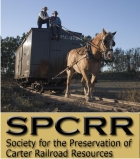

Reference Data.
Corporate Ownership.Salt Lake, Sevier Valley & Pioche Railroad
May 3, 1872 – August 1874
Utah Western Railway
August 1874 – February 15, 1881
Utah & Nevada Railway
[Union Pacific Subsidiary]
February 15, 1881 – August 19, 1889
Oregon Short Line & Utah Northern
[Union Pacific Subsidiary]
August 19, 1889 – March 16, 1897
Oregon Short Line
[Union Pacific Subsidiary]
March 16, 1897 – June 1902
Mainline Length.
20 Miles (Graded).
Rail Weight.
35lb.
Salt Lake, Sevier Valley & Pioche Railroad.
I ncorporated on May 3, 1872, by a group of Salt Lake businessmen and Eastern investors, the Salt Lake, Sevier Valley and Pioche Railroad was projected to reach the promising mining regions in western Utah. The railroad planned to build west from Salt Lake City to Stockton and then on to western edge of Utah territory. There was further intention to build the railroad through the valley of the Sevier River to the border of Utah Territory and toward the mines around Pioche in Southern Nevada.1
John Leisenring of Pennsylvania was selected to be president of the railroad; H. S. Jacobs, vice president; and E. M. Barnum, secretary. William Lilley, Juab Lawrence, Patrick E. Connor, Jeter Clinton, Thomas P. Akers, John Thomas, John Rowberry, James Campbell and H. R. Duke were named as directors.
For the first year, little progress was made in construction due to a lack of funding and interest among Eastern financiers. In January 1873 the railroad was able to successfully raise capital among the residents of Tooele. On April 14, 1873 ground was broken on the railroad in Salt Lake City on South Temple Street near the Utah Central Railroad depot.2
Grading westward began shortly afterward. Crews worked in multiple locations, including construction of the bridge over the Jordan river, 8 miles west of Salt Lake City. The first five miles of roadbed west from Salt Lake City was completed by May. The company also arranged for the purchase of the stern-wheel boat “City of Corinne” for use at a planned resort at Lake Point.
At the first annual board meeting in May 1873, the company elected H.S. Jacobs as President of the company; Patrick Edward Connor, vice president and treasurer; E. M. Barnum, secretary; and H. P. Kimball, general superintendent.
On July 8, 1873 the first locomotive arrived from Brooks Locomotive Works. The ornate little mogul was named “Kate Conner” after General Patrick E. Conner’s daughter. The first pieces of rolling stock, 2 box cars, one construction car, and two hand cars arrived on July 11.3 Rail started arriving from the East in August. The company hoped to have the rails in place to Lake Point that winter.
During the month of September, the company graded twenty miles of right of way. On September 23, track laying began westward out of Salt Lake City. Mr. William F. Tully was put in charge of track laying. The effort was short lived; construction was halted on September 30th due to a lack of funds.
In the final months of 1873, a dispute between the directors over the payment for rail lead to accusations that Jacobs had been misusing company funds and taking the investors along for a ride. In response, he resigned as President on August 1, 1873. In the wake of Jacobs’ resignation, General Conner would become the superintendent in charge.
Early in the month of May 1874 the first passenger car arrived from J.G. Brill Company, a handsome coach.4 A smoking car was also constructed by Brill, but would not be delivered. By the end of May, the railroad’s outlook looked dim.
Embarrassed by the situation with the board of directors, the SLSV&P was forced to file for bankruptcy in early 1874. As the charges and counter-charges involving Jacobs were being aired, the railroad was moving towards bankruptcy. The remaining rail on hand, still loaded on flat cars, was sold to the Utah Northern Railroad at a loss.5 The locomotive “Kate Conner” was sold to the Utah Western Railroad where it was renamed "Oquirrh".
The company reorganized as the Utah Western Railroad. John W. Young. The officers of the Salt Lake, Sevier Valley and Pioche Railroad agreed to transfer their claims to the right-of-way, roadbed, bridges, buildings and remaining construction equipment to the Utah Western in return for stock in the new company and for assuming the old company's remaining debts.
In 1881 the Utah Western was sold under foreclosure, becoming part of the Utah & Nevada Railway, a subsidiary of the Oregon Short Line Railway. On July 27, 1889, the Utah & Nevada Ry. was consolidated into the Oregon Short Line & Utah Northern Railway. After the OSL&UNRy declared bankruptcy, it was transferred to the Oregon Short Line Railroad on March 16, 1897. The Oregon Short Line was then leased to the Union Pacific Railroad on January 1, 1936 and operated as part of the UP system. Finally, on December 30, 1987, the OSL formally merged with Union Pacific.
2. Salt Lake Herald, April 15, 1873.
3. Utah Mining Gazette, September 13, 1873.
4. Salt Lake Daily Tribune, May 6, 1874.
5. Deseret Evening News, August 31, 1874.
Bibliography
Reeder, Clarence Railoads of Utah Thesis.
SL,SV & PRR at "Utah Rails" by Don Strack
Farrell, Mallory Hope. "Nevada Central Narrow Gauge".
Hilton, George "American Narrow Gauge".
Carr, Stephen L. and Edwards, Robert W. Utah Ghost Rails Western Epics, Salt Lake City 1989.
Reference Material Available Online:
Collected Salt Lake, Sevier Valley & Pioche Railroad Photographs.
Images collected from private collections, libraries and historical societies.



